I get it: we’re all frustrated with this sluggish stock rebound. It’s been almost two years since stocks last hit all-time highs, and the S&P 500 is still sitting some 11% below the peak!
So let’s take a look at what’s behind this patience-testing market—and unpack a smart contrarian dividend play to take advantage.
2023 Is Not 2020 (or 2018)
Today’s frustration is understandable because over the last decade, we’ve grown used to markets that bounce quickly after a crash, with the 2020 COVID crash-and-rebound being the classic case. And we recovered so quickly from the 2018 pullback that you can be forgiven if you forgot about that one entirely!
Fast-forward to summer 2023, and stocks weren’t even fully recovered before they started to correct again. And now they’re even lower off all-time highs (but still on an upward trajectory), as you can see by the percentage off highs the benchmark ETFs for the S&P 500 (in purple below) and the NASDAQ (in orange) are showing.
The 2023 Rebound Stalls
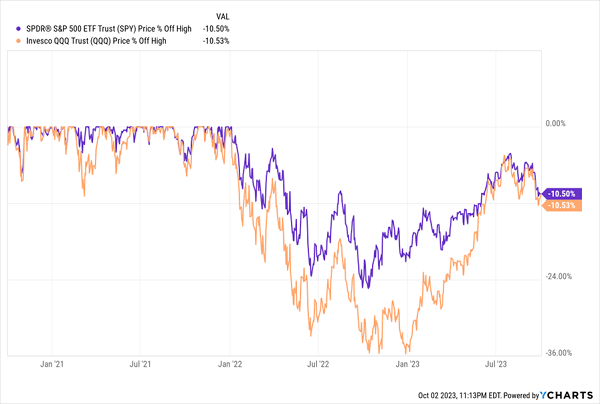
So what’s the difference this time? It can be summed up in three words: the Federal Reserve.
The Fed is doing something very different from the last decade. In fact, we have to go back to 2008 to see a rebound that looks similar to our current one. But there is a critical difference between now and then: 15 years ago, US GDP was on a slower course …
2008: Sluggish GDP, Sluggish Stock Rebound
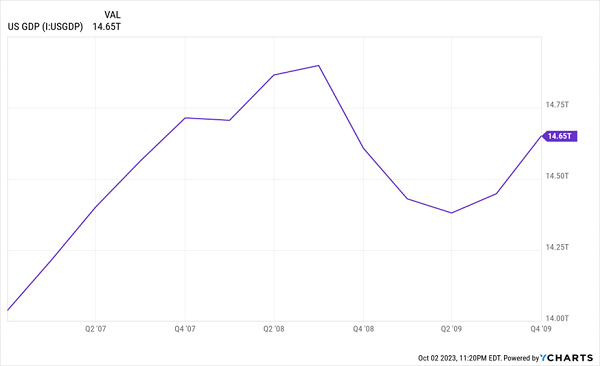
That makes sense. But what doesn’t make sense is today’s sluggish stock-market rebound when GDP growth is riding steadily higher.
2023: Soaring GDP … Sluggish Stocks?
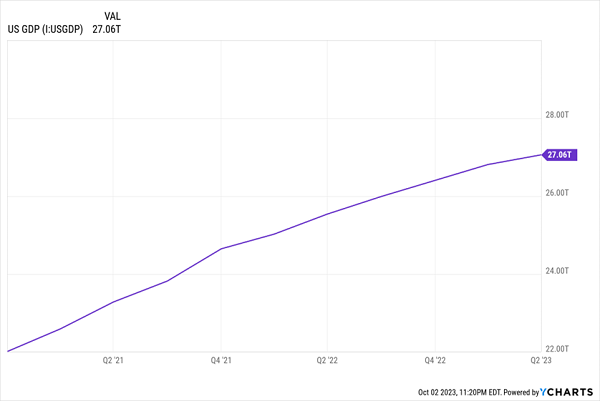
In other words, we’re now in an economically much stronger position than we were post-2008, but stocks have slipped in recent weeks. That brings us back to the Fed.
When the Fed cut interest rates in 2007, the stock market kept crashing because investors felt the crisis was so severe that the Fed couldn’t fix it.
That was incorrect, and as a result, stocks kept rising throughout the 2010s, during that low-interest-rate environment. “Don’t fight the Fed” became a catchphrase as low rates were thought to drive stock prices upward and high rates would put pressure on them, which is why stocks pulled back in 2016, when the Fed started raising rates.
Except stocks then went on to flourish as Fed rate hikes continued into 2019.
Stocks Rose With Rates From ’16 to ’19
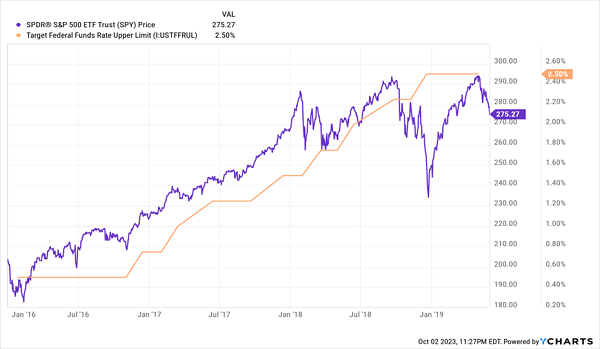
This is not normal: stocks didn’t act this way before the 2008 crisis.
We’re going back to a high-interest-rate world, and that’s why stocks now rise more slowly and crashes last longer: investors believe the Fed isn’t there to support the market anymore, and they’re worried. But this is how things are in higher-rate environments.
When rates are high, stocks respond to rising GDP by going up—they don’t cheer bad news like they did in 2022 and this year. That’s unlikely to last, even if investors think it will, due to recency bias.
A 10% Dividend That’s Perfect for This Weird Market
Covered-call closed-end funds (CEFs) like the 10%-yielding Virtus Equity & Convertible Income Fund (NIE) are a smart way to play this market.
It’s a mixed fund that gets high income from bond-like assets, upside from stocks as they rise in the longer run and income from flat or slowly recovering markets, or markets seeing some volatility, like we’ve experienced in recent weeks.
That kind of strategy would be hard for us to run ourselves, which is the beauty of CEFs: we can profit from these complex strategies without the legwork because we’re hiring professional portfolio managers to do it on our behalf.
A Portfolio for Today’s Market
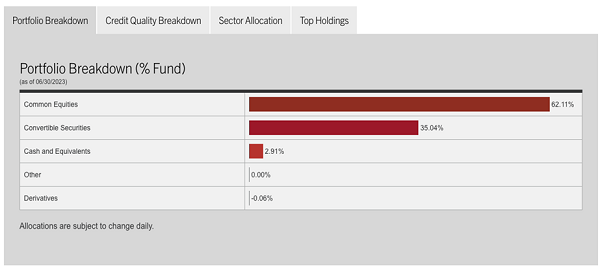
Source: Virtus.com
With exposure to high-quality, cash-flow-rich companies like Microsoft (MSFT), Alphabet (GOOG, GOOGL) and Apple (AAPL), this is hardly a risky fund. Nor is it too cautious or too far behind the times: with 1.4% exposure to NVIDIA (NVDA), there is tech-stock upside here, as well.
The genius behind NIE is that it mitigates the risk of this growth exposure by holding a quarter of its assets in convertible bonds and other kinds of high-yielding debts. It doubly mitigates it by selling covered-call options on some of its stock holdings. This provides extra support for the dividend and works best in flat or slowly-recovering markets—the two scenarios that are likely for us, and that we’ve been in for months.
Moreover, NIE soared during the very slow recovery from the 2008 crisis.
NIE Performed Well in the Last “Drawn Out” Recovery

This kind of outperformance hasn’t happened yet this time around (NIE is up 19.3% from the bottom in October 2022, a bit less than the S&P 500 since then), which is a good thing. That means this 10.1%-yielding fund’s outperformance is still on sale. But that won’t last.
4 More Terrific CEF Plays for This Jumpy Market (Average Yield: 9.5%)
This “out-of-step” stock market has kept discounts wide on many other CEFs, too—including 4 CEF “yield machines” I’m urging investors to buy now.
This cash-rich quartet pays an outsized 9.5% average yield. And these smartly run income plays are still on sale following the 2022 market rout.
That’s our cue to buy. Simply click here to read my exclusive investor bulletin on this special—and temporary—situation. In it, I’ll reveal my full CEF-investing strategy and give you the opportunity to download a free Special Report naming all 4 of these unloved (for now) 9.5% payers.
Before you make your next trade, you'll want to hear this.
MarketBeat keeps track of Wall Street's top-rated and best performing research analysts and the stocks they recommend to their clients on a daily basis.
Our team has identified the five stocks that top analysts are quietly whispering to their clients to buy now before the broader market catches on... and none of the big name stocks were on the list.
They believe these five stocks are the five best companies for investors to buy now...
See The Five Stocks Here
Discover the next wave of investment opportunities with our report, 7 Stocks That Will Be Magnificent in 2025. Explore companies poised to replicate the growth, innovation, and value creation of the tech giants dominating today's markets.
Get This Free Report